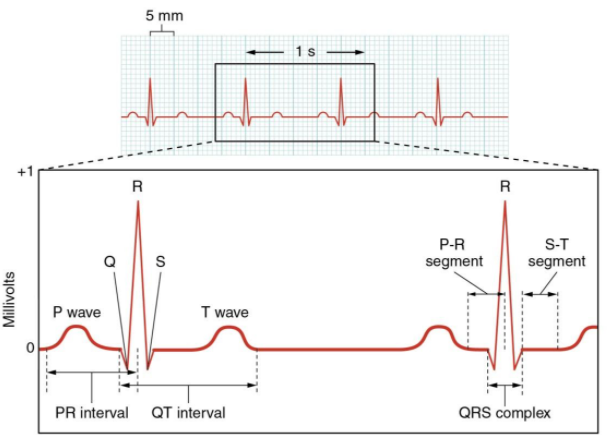
Answer
456.3k+ views
Hint:ECG stands for Electrocardiogram, which records the heart signals with the help of electrodes placed on the body of a patient.
Complete answer:
ECG:-
>It records the electrical signal from the heart in order to check heart condition.
>It is a painless test.
>It is a graphical representation showing waves
>Electrodes are placed on the chest of the patient to record his/her heart condition.
>The signals are shown in a monitor or computer attached with the ECG machine.
Waves of ECG:-
The ECG include:
1) P Wave
2) Q Wave
3) S Wave
4) R Wave
5) U Wave
6) T Wave
P- Wave:-
In ECG, the P-Wave represents Atrial depolarization. This Atrial depolarization results in atrial contraction or atrial systole.
Q- Wave:-
In ECG, the Q- Wave represents Ventricular depolarization. The Q Wave is an initially negative deflection of the QRS complex.
S- Wave:-
In ECG, the S-Wave signifies the Ventricular depolarization. The S wave is the first downward deflection of QRS complex occurs after the R wave.
R- Wave:-
In ECG, the R-Wave represents the Ventricular depolarization. It is the first positive wave of the QRS complex.
U- Wave:-
U wave represents the ventricular repolarization. This wave comes after the T wave.
T- Wave:-
T waves represent the ventricular repolarization. The T wave comes after the QRS complex.

Therefore, from the above discussion it is clear that in ECG, the P- wave represents Atrial depolarization.
Hence option “C” is the correct answer.
Note:Remember to keep in mind that there is no distinct wave for atrial repolarization so don’t get confused with it. All the waves in the QRS complex show ventricular depolarization.
Complete answer:
ECG:-
>It records the electrical signal from the heart in order to check heart condition.
>It is a painless test.
>It is a graphical representation showing waves
>Electrodes are placed on the chest of the patient to record his/her heart condition.
>The signals are shown in a monitor or computer attached with the ECG machine.
Waves of ECG:-
The ECG include:
1) P Wave
2) Q Wave
3) S Wave
4) R Wave
5) U Wave
6) T Wave
P- Wave:-
In ECG, the P-Wave represents Atrial depolarization. This Atrial depolarization results in atrial contraction or atrial systole.
Q- Wave:-
In ECG, the Q- Wave represents Ventricular depolarization. The Q Wave is an initially negative deflection of the QRS complex.
S- Wave:-
In ECG, the S-Wave signifies the Ventricular depolarization. The S wave is the first downward deflection of QRS complex occurs after the R wave.
R- Wave:-
In ECG, the R-Wave represents the Ventricular depolarization. It is the first positive wave of the QRS complex.
U- Wave:-
U wave represents the ventricular repolarization. This wave comes after the T wave.
T- Wave:-
T waves represent the ventricular repolarization. The T wave comes after the QRS complex.

Therefore, from the above discussion it is clear that in ECG, the P- wave represents Atrial depolarization.
Hence option “C” is the correct answer.
Note:Remember to keep in mind that there is no distinct wave for atrial repolarization so don’t get confused with it. All the waves in the QRS complex show ventricular depolarization.
Recently Updated Pages
Identify the feminine gender noun from the given sentence class 10 english CBSE

Your club organized a blood donation camp in your city class 10 english CBSE

Choose the correct meaning of the idiomphrase from class 10 english CBSE

Identify the neuter gender noun from the given sentence class 10 english CBSE

Choose the word which best expresses the meaning of class 10 english CBSE

Choose the word which is closest to the opposite in class 10 english CBSE




